- Location and arrival
- Photographic opportunities
- Lake Günzer
- The hide
- Away from the cranes
- The equipment
- Conclusion
- Download map of the Zingst and Darß
The Rügen-Bock region is located on the Baltic Sea coast of Mecklenburg-Western Pomerania. The open Baltic Sea is separated from the coast by the Fischland-Darß-Zingst
peninsula. This creates a unique lagoon landscape between the mainland and the peninsula, which is used as a sleeping place by the cranes among others.
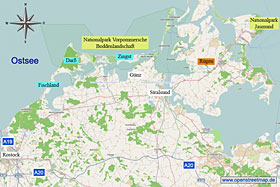
For better orientation, I have attached an overview map on the left (for more details, please click on the map on the left). The cranes, also called
birds of luck, can be found throughout the Darß-Zingst region and also on Rügen. In the fall, during the main migration period between October and November, up to 60,000
cranes can be found in the region. However, the best chances for observing and photographing cranes are near the feeding stations. The feeding stations are set up so that
the cranes do not eat all of the winter crops from the farmers' fields. One of these feeding stations is located at Lake Günz, so it is recommended to look for
accommodation near Günz. There are plenty of rooms and vacation rentals in the region, but I would still recommend booking in advance.
(back to the top)
The cranes are spread throughout the entire region. Typically, they leave their sleeping places in the lagoon landscape with the dawn and fly to the harvested
cornfields, where they search for corn kernels left behind by the harvesting machines. Here, I have attached a small
map of the region that can give you a
rough idea of the area. Additionally, I can recommend a visit to the
Crane Information Center in Groß Mohrdorf,
where you can purchase a very good map of the area. The information center is located in the middle of the small town of Groß Mohrdorf.
There are various observation points from which you can observe the departure from or the return to the sleeping places. Unfortunately, we cannot provide a general recommendation as
the flight routes depend on many factors. For example, the exact location where the cranes in the lagoon choose their sleeping places depends on the strength of the wind or the water
level. Good opportunities to photograph the morning arrival, for example, can be found in
Bresewitz. There, you can either stand on the
Meiningen bridges or position yourself at the end of the peninsula at the viewing point. With a bit of luck, you can photograph crane chains starting from the island of Oie in the
morning with the backdrop of the rising sun.

To witness the arrival of cranes to their sleeping places at sunset, one option would be the lookout point in
Bisdorf.
You can drive up to the parking lot in Bisdorf and then follow the forest path to the observation hut. A little further west is a lookout point in Kinnbackenhagen, which also offers
another opportunity to observe the evening arrival. In the far north of the mainland, there is the
Zarrenzin lookout point, which is also suitable
for watching the arrival in the evening. Here, you have a view towards the islands "Kleine Werder" and "Bock". However, as mentioned at the beginning, there is no guarantee of a
sunset or the passing of cranes.
Furthermore, I can recommend the Utkiek in Hohendorf. This is a converted barn where you can look directly onto a cornfield. This location is less suitable for photography as you have
a high overhead view of the field, although aerial shots may be possible. During my visit, the cornfield had not yet been harvested, so there were no cranes present at the time.
(back to the top)

The Günzer See is with out a doubt one of the hotspots among nature photographers. This is due to the fact that during migration times, a feeding area is set
up on the meadow in front of the lake. I have marked on
this map the conditions on site. There is a
small parking lot from which you have a view of the meadow. The parking lot is the only parking option near the feeding area and on some days it can be difficult to find a parking
spot there. The photographic opportunities at Günzer See are very good, as the cranes here have a slightly lower flight distance. However, from the parking lot, you will need at
least a 500-600mm focal length lens and will mostly only be able to capture a small group of cranes in full frame. Aerial shots are better, as the cranes occasionally fly directly
overhead, but they usually turn away when they see people in the parking lot. The best time for aerial shots at Günzer See is in the morning, as the photographer will face more
backlighting later in the day.
To the left of the parking lot is an
observation platform
that provides a good overview of the lake and the cranes. During the main migration period, from October to November, there are often 500 to 1000 cranes to be observed on the
meadow.
Overall, the Lake Günzer offers a very good opportunity for crane photography, but I don't want to ignore the fact that the location has little to do with tranquility and
contemplation, as one might expect from nature photography. The place attracts too many
crowds. For exchanging experiences and conversations among
nature photographers, it is certainly very enriching, but fortunately, there are still plenty of photographic alternatives in the area ;-)
(back to the top)
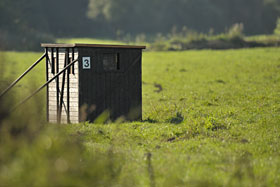
At Günzer See, it is possible to rent one of three photography hides. The rental fee is considered a donation to crane conservation and is 85 euros per day
for one person (as of fall 2020). Those who wish to rent one of the hides should do so several months in advance, as they are in high demand. The hides can be booked through the
website of
"Crane Protection Germany".
Those who rent a photography hide must strictly adhere to the rules of conduct that they accept upon booking. The most important rule to be aware of is that you must enter the hide
before sunrise and may not leave until after sunset. Therefore, it is important to have some experience with sitting in a hide or tent in order to estimate whether you can withstand
the long hours in the photography hide. There is a bucket provided in the hide for emergencies.
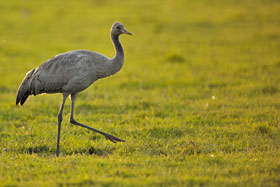
The photo huts are designed for two people each, but I would advise everyone to rent the huts individually as the space is quite cramped (dimensions
approximately height: 1.6m, width: 2m and depth: 1.3m). You can take a look inside the photo hut here:
Click here.
.
You should definitely bring a seating option. There are windows on each side of the hut that must be opened one at a time so as not to disturb the cranes with the translucent light.
Additionally, the lens should not protrude from the window as the cranes are extremely sensitive to any movements.
In principle, I consider renting the hide worthwhile, but it should also be noted that there is no guarantee of cranes placing themselves directly in front of the hide. Additionally,
after the morning, you will have to deal with more and more backlight, which can be very appealing in the evening.
(back to the top)
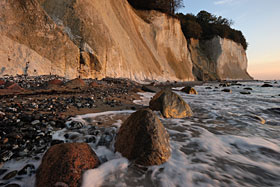
n addition to crane photography, the region offers plenty of other activities. It takes about an hour's drive to reach Jasmund National Park on Rügen. There, it
is worth taking pictures of the chalk cliffs, but the beech forests are also a worthwhile destination. The chalk coast stretches for about fifteen kilometers between Sassnitz and Lohme.
To explore the chalk cliffs, there is the Hochuferweg, which leads along the slopes through the beech forests, or you can explore the coast along the beach path. However, the coastal
path consists of a pebble beach and requires some effort for the walk. However, you don't need to walk that far, as there are plenty of photo opportunities in the first hundred meters.
Since the chalk cliffs are located on the east coast, I recommend visiting the coast in the early morning hours when the light is the most beautiful.
If you would like more information about nature photography on Rügen, I refer you to my
travel report about Rügen.
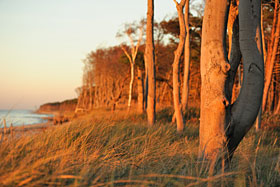
Another recommendation from me for landscape photography would be the
west coast of Darß. There is a sandy beach on the coast,
and behind the beach belt, there is a forested area. The location of the forest ensures that the evening sun illuminates the forest very nicely. Shortly before sunset, the forest glows red
as a result. At the beach itself, you can find plenty of deadwood, which can be incorporated nicely into the composition of your photos. However, before reaching the forest from the parking
lot, you need to hike up the beach towards the north for about 45 minutes. The west beach can also be reached from the northern tip, but I have not yet explored the area there and cannot
write anything about it.
(back to the top)
Cranes are very shy birds in Germany, and flight distances of several hundred meters are not uncommon. Even if the cranes at Lake Günzer are somewhat more accustomed
to humans, it is still advisable to bring as much focal length as possible. Focal lengths of 500-600mm are recommended to capture the birds in a reasonably filling format.
For flight shots or shots from the hide, telephoto lenses with less focal length are also suitable. In addition to a tripod and warm clothing, a seating option should
also be brought for the hide. For those who enjoy landscape photography, it is advisable to pack wide-angle lenses and small telephoto lenses.
(back to the top)
I can really recommend the region around Zingst, Darß, Fischland, and Rügen. Especially during the migration periods of the cranes in spring and autumn. Besides the
unforgettable wildlife experience with the cranes, the area is also very scenic. For me personally, it was certainly not my last visit.
(back to the top)
Here you can download maps for the Rügen-Bock region. To view and print them, you will need an Acrobat Reader. I hope the maps will help you get to know and navigate
the area.
 map of the Rügen-Bock Region
map of the Rügen-Bock Region
written: November 2010, (author: Olaf Juergens)
updated: October 2011
 print version
print version










